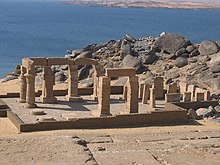Gerf Hussein
Location in Egypt |
Gerf Hussein was about 90 km south of Aswan in Lower Nubia , where an ancient Egyptian rock temple from the reign of Ramses II stood. Gerf Hussein was a few kilometers south of Dendur , on the west side of the Nile , and is now covered by Lake Nasser .
The temple was built by the viceroy of Kush Setau and was dedicated to the deities Ptah , Ptah- Tatenen , Hathor and the god-king Ramses II. The 65 m long temple complex was partially built into the rock and was similar in plan to the Great Temple of Abu Simbel . The front half consisted of a free-standing pylon followed by a courtyard, which was surrounded by six columns and eight statue pillars . From the first pylon to the Nile there was an avenue of rams sphinx. The back part, carved into the rock, was 43 m deep and had a pillar hall with six statue pillars, as well as four lateral statue niches with divine triads on the long walls. Behind it followed the offering table room and barge sanctuary , on the back wall of which there were four cult statues carved out of the rock.
Some parts of the temple were rebuilt on the island of New Kalabsha near Aswan. A colossal statue of Ramses II from Gerf Hussein is now in the Nubian Museum in Aswan.
literature
- Dieter Arnold : The temples of Egypt . Artemis & Winkler, Zurich 1992, ISBN 3-7608-1073-X , p. 85 .
- Jean Jacquet, Hassan el-Achirie, MAL Tanbouli: Gerf Hussein . 3 volumes (1974-75, 1978) - (French).
- Richard H. Wilkinson : The world of temples in ancient Egypt . Scientific Book Society, Darmstadt 2005, ISBN 3-534-18652-4 , pp. 219 .
Web links
- Craig Hildreth: The Temple of Gerf Hussein in Nubia ( English ) Retrieved on April 6, 2011th
Individual evidence
- ^ Arnold: The temples of Egypt. P. 85.
- ↑ Craig Hildreth: The Temple of Gerf Hussein in Nubia ( English ) Retrieved April 6, 2011.
Coordinates: 23 ° 17 ′ 0 ″ N , 32 ° 54 ′ 0 ″ E

